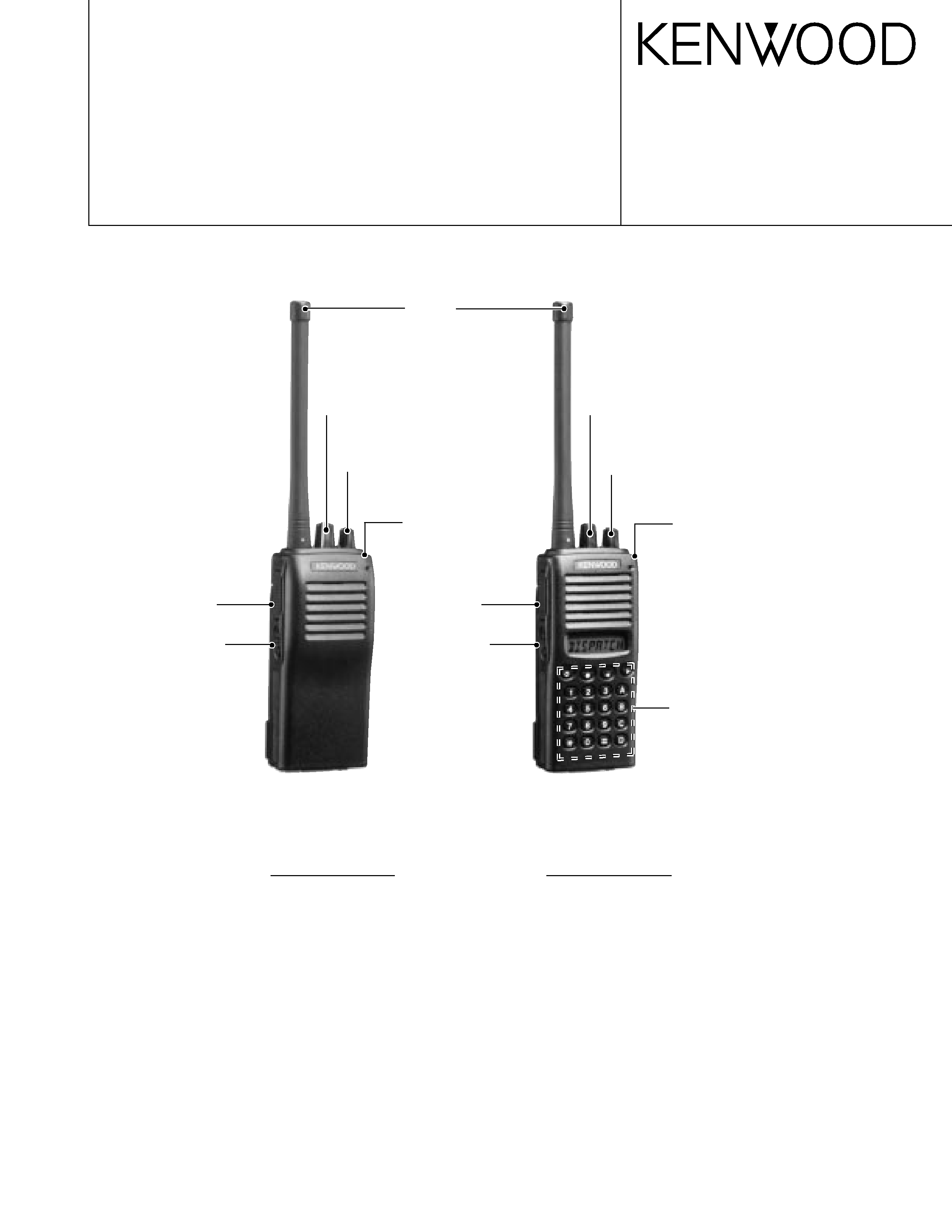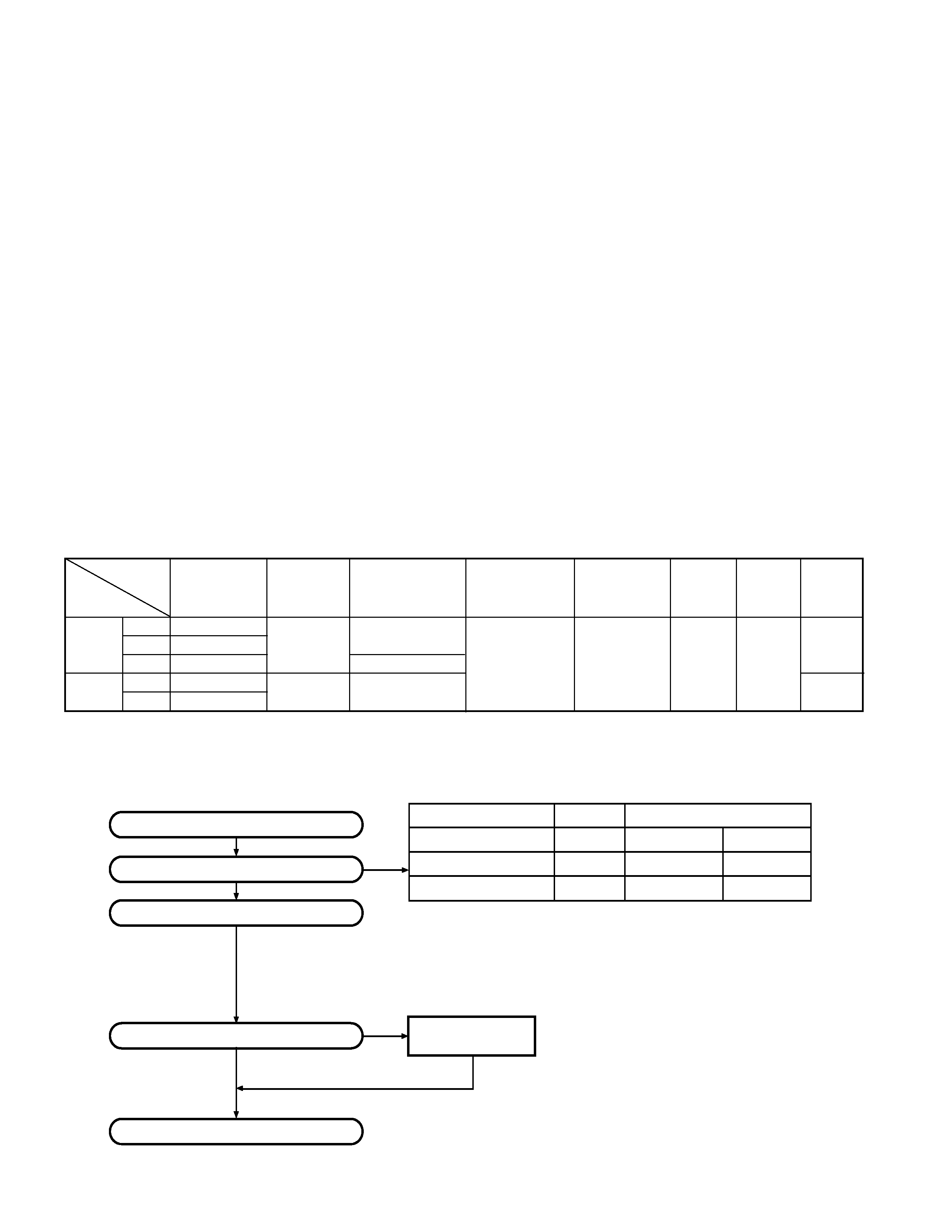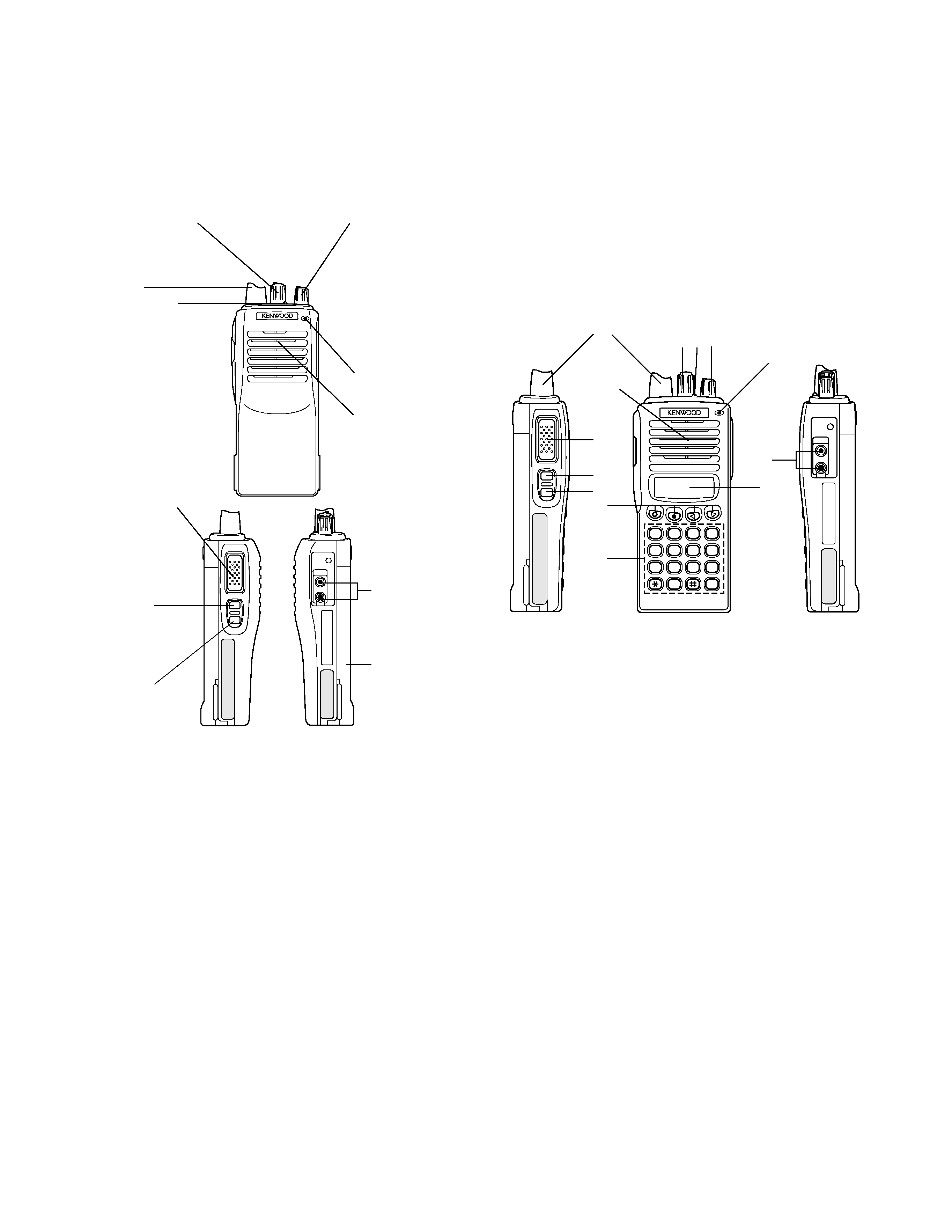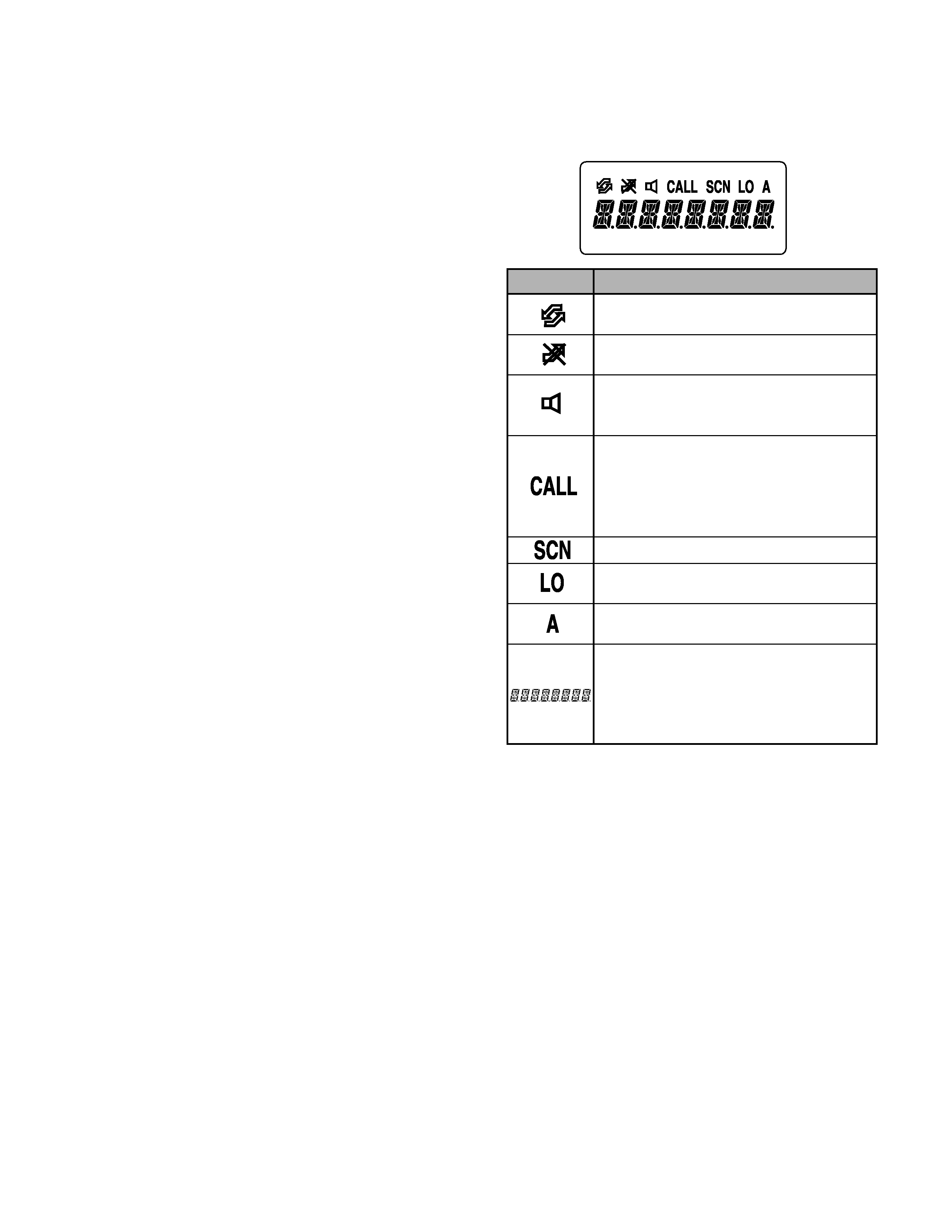
VHF FM TRANSCEIVER
TK-260G/(N)/270G/(N)
© 2000-4 PRINTED IN JAPAN
B51-8532-00(S) 570
SERVICE MANUAL
GENERAL ...................................................................... 2
SYSTEM SET-UP .......................................................... 2
OPERATING FEATURES .............................................. 3
REALIGNMENT ............................................................. 8
DISASSEMBLY FOR REPAIR ..................................... 17
CIRCUIT DESCRIPTION ............................................. 18
SEMICONDUCTOR DATA .......................................... 22
DESCRIPTION OF COMPONENTS ............................ 24
PARTS LIST ................................................................. 25
EXPLODED VIEW ....................................................... 33
PACKING ..................................................................... 35
CONTENTS
Key top (DTMF)
(K29-5330-02)
TK-260G
TK-270G
ADJUSTMENT ............................................................. 36
PC BOARD VIEWS
DISPLAY UNIT (X54-3250-10) ............................... 47
TX-RX UNIT (X57-587X-XX) .................................. 49
SCHEMATIC DIAGRAM .............................................. 55
BLOCK DIAGRAM ....................................................... 63
LEVEL DIAGRAM ........................................................ 65
KNB-14/KNB-15A (Ni-Cd BATTERY) .......................... 66
OPTIONS ..................................................................... 67
SPECIFICATIONS ................................... BACK COVER
Knob (CHANNEL SELECTOR)
(K29-5341-03)
Knob (VOL)
(K29-5332-03)
Cabinet assy
(A02-2391-23)
Knob (PTT)
(K29-5334-13)
Antenna
(T90-0695-15):E,(N)E
(T90-0680-05):(N)T
(T90-0681-05):(N)E2
Knob (ENC)
(K29-5331-03)
Knob (VOL)
(K29-5332-03)
Cabinet assy
(A02-2385-23)
Knob (PTT)
(K29-5334-13)
Knob (Side1)
(K29-5333-13)
Knob (Side1)
(K29-5333-13)
E VERSIONS
M market models are shown.

TK-260G/(N)/270G/(N)
2
GENERAL / SYSTEM SET-UP
INTRODUCTION
SCOPE OF THIS MANUAL
This manual is intended for use by experienced technicians
familiar with similar types of commercial grade communications
equipment. It contains all required service information for the
equipment and is current as of the publication date. Changes
which may occur after publication are covered by either Service
Bulletins or Manual Revisions. These are issued as required.
ORDERING REPLACEMENT PARTS
When ordering replacement parts or equipment information,
the full part identification number should be included. This
applies to all parts, components, kits, or chassis. If the part
number is not known, include the chassis or kit number of which
it is a part, and a sufficient description of the required
component for proper identification.
PERSONNEL SAFETY
The following precautions are recommended for personnel
safety:
q
DO NOT transmit until all RF connectors are verified secure
and any open connectors are properly terminated.
q
SHUT OFF and DO NOT operate this equipment near
electrical blasting caps or in an explosive atmosphere.
q
This equipment should be serviced by a qualified technician
only.
SERVICE
This radio is designed for easy servicing. Refer to the
schematic diagrams, printed circuit board views, and alignment
procedures contained within.
NOTE
The terms "Wide" and "Semi wide" used in this service
manual correspond to "Wide 5K" and "Wide 4K" respectively
that appear in the menu and help texts of the KPG-56D (Field
Programming Unit).
SYSTEM SET-UP
Merchandise received
Choose the type of transceiver
Transceiver programming
Delivery
Are you using the speaker microphone?
A personal computer (IBM PC or compatible), programming
interface (KPG-22), and programming software (KPG-56D)
are required for programming.
(The frequency, TX power HI/LOW, and signalling data are programmed
for the transceiver.)
YES
NO
KMC-17 or KMC-21
Speaker microphone
(Option)
TX/RX 146~174
5.0W
TK-260G (N)E,(N)T TK-270G (N)E,(N)T
Frequency range (MHz) RF power
Type
TX/RX 146~174
5.0W
TK-260G E
TK-270G E
TX/RX 136~150
5.0W
TK-260G (N)E2
Unit
Model &
TX-RX Unit
Display Unit
Frequency range
Remarks
Helical Antenna
Charger
Battery
16 Key
destination
E
X57-5872-71
146~174MHz
TK-260G (N)E,(N)T
X57-5872-72
_
IF1 : 49.95MHz
_
(N)E2
X57-5872-75
136~150MHz
LOC : 50.4MHz
O
OP
OP
TK-270G
E
X57-5872-73
X54-3250-10
146~174MHz
O
(N)E,(N)T
X57-5872-74

TK-260G/(N)/270G/(N)
3
OPERATING FEATURES
1. Operation Features
· TK-260G
Antenna
A
3
2
1
B
6
5
4
C
9
8
7
D
0
q
q
q
q
q
e
e
e
e
e
r
r
r
r
r
t
t
t
t
t
y
y
y
y
y
u
u
u
u
u
i
i
i
i
i
o
o
o
o
o
!0
!0
!0
!0
!0
w
w
w
w
w
Microphone
Speaker
The transceiver is shown with the optional KNB-14 battery pack.
q
q
q
q
q Rotary encoder
Your dealer can program the encoder as either
Group Up/Down or Channel Up/Down (default
setting). Rotate to select a group or channel. Also
rotate to adjust the squelch in Squelch Adjustment
mode.
w
w
w
w
w LED indicator
Lights red while transmitting. Lights green while
receiving. Flashes orange while receiving a Code
Squelch or a Selective Call code, or a 2-Tone or
DTMF signal that matches the one set up in your
transceiver. Flashes red when the battery power is
low while transmitting.
e
e
e
e
e Power switch/ Volume control
Turn clockwise to switch ON the transceiver.
Rotate to adjust the volume. To switch OFF the
transceiver, turn counterclockwise fully.
r
r
r
r
r PTT (Push-to-Talk) switch
Press this switch, then speak into the microphone
to call a station.
t
t
t
t
t Side 1 key
This is a PF (Programmable Function) key. Press
it to activate its auxiliary function (page 4).
y
y
y
y
y Side 2 key
This is a PF (Programmable Function) key. Press
it to activate its auxiliary function (page 4).
Programmable Auxiliary Functions
Side 1 key and Side 2 key can each be programmed
with one of the following auxiliary functions:
· Monitor A (Monitor UnmuteMomentary): Press and
hold the Monitor key to hear background noise. Release
the key to return to normal operation.
· Monitor B (Monitor UnmuteToggle): Momentarily
press the Monitor key to hear background noise. Press
the key again to return to normal operation.
· Monitor C (Carrier SquelchMomentary): Press and
hold the Monitor key to deactivate QT, DQT, 2-Tone, or
DTMF signalling. Release the key to return to normal
operation.
· Monitor D (Carrier SquelchToggle): Momentarily
press the Monitor key to deactivate QT, DQT, 2-Tone, or
DTMF signalling. Press the key again to return to normal
operation.
· None: No function.
· RF Power Lo: Press the RF Power Lo key to toggle the
output power of a channel between high and low. This
can only be used for channels that have been
programmed with high power. Pressing RF Power Lo
while using a channel programmed with low power
Microphone
Speaker
Antenna
Channel selector
Rotate to select a
channel (1 ~ 8).
LED indicator
Lights red while
transmitting. Lights
green while receiving.
Flashes orange while
receiving a 2-Tone or
DTMF signal that
matches the one set
up in your transceiver.
Flashes red when the
battery power is low
while transmitting.
Power switch/
Volume control
Turn clockwise to
switch ON the
transceiver.
Rotate to adjust
the volume. To
switch OFF the
transceiver, turn
counterclockwise
fully.
PTT (Push-to-
Talk) switch
Press this
switch, then
speak into the
microphone to
call a station.
Side 2 key
Press to
activate its
programmable
function.
Side 1 key
Press to
activate its
programmable
function.
SP/MIC jacks
Connect an
optional speaker/
microphone here.
The transceiver is
shown with the
optional KNB-14
battery pack.
causes an error tone to sound. (When changing a
channel from high to low power, all channels
programmed with high power are changed to low.)
· 2-Tone Encode Select: To transmit using a 2-Tone
code, press the PTT switch and the 2-Tone Encode
Select key, then speak into the microphone in your
normal voice.
Release the PTT switch and 2-Tone Encode Select key
to receive.
· TK-270G

TK-260G/(N)/270G/(N)
4
OPERATING FEATURES
u
u
u
u
u
°,·,22222,33333keys
These are PF (Programmable Function) keys. Press
each key to activate its auxiliary function.
i
i
i
i
i DTMF keypad
Used for storing and transmitting DTMF numbers.
o
o
o
o
o SP/MIC jacks
Connect an optional speaker/ microphone here.
!0
!0
!0
!0
!0 Display
(See page 5.)
Note: The PF keys are programmed with default functions:
·
Side 1 key: Lamp
·
Side 2 key: Monitor A
·
°key: Scan
·
· key:
Scan Del/Add
·
2
2
2
2
2 key:
Talk Around
·
3
3
3
3
3 key:
RF Power Lo
Programmable Auxiliary Functions
Side 1, Side 2,
°,·, 22222,and 33333canbeprogrammed
with the auxiliary functions listed below.
· Channel Down
· Channel Up
· Display Character
· Group Down
· Group Up
· Home Channel
· Key Lock
· Lamp
· Monitor A (Monitor UnmuteMomentary)
· Monitor B (Monitor UnmuteToggle)
· Monitor C (Carrier SquelchMomentary)
· Monitor D (Carrier SquelchToggle)
· None
· Redial
· RF Power Lo
· Scan
· Scan Del/Add
· Talk-Around
· 2-Tone Encode Select
2. Programmable keys
The functions the FPU programs to the function keys are
described in the following sections.
1) Channel up/down (TK-270G only)
When the key is pressed each time, the channel number to
be selected is incremented/decremented and repeats if held
for one second or longer.
2) Display character (TK-270G only)
This key switches the LCD display between the group/
channel number and group/channel name.
3) Group up/down (TK-270G only)
When the key is pressed each time, the group number to
be selected is incremented/decremented and repeats if held
for one second or longer.
4) Home Channel (TK-270G only)
Press this key once, the channel switches to the pre-
programmed home channel.
5) Key lock (TK-270G only)
When the KEY LOCK switch is held down for one second
or more, keys other than [PTT], [Side1], [Side2], [VOL],
[POWER], and KEY LOCK are locked.
When 12/16 KEY LOCK is set with the FPU, the DTMF
key is locked and when front-panel KEY LOCK is set, the
DTMF key and the [PF] key are locked.
6) Lamp (TK-270G only)
This key illuminates the LCD and keys on the front panel.
When the key is pressed, the LED lamp goes on.
When it is released, the lamp goes off after about five
seconds. If any key is pressed while the LED lamp is on,
the lamp is kept on for five seconds.
7) Monitor
Used to release signalling or squelch when operating in
conventional mode. It is also used to reset option signalling.
8) 2-Tone Encode Select (TK-270G only)
1 Press the key programmed as 2-tone Encode Select.
· A pre-programmed 2-tone code name appears on the
display.
2 Press the key programmed as Rotary encoder to select
you desired 2-tone code name.
3 Press PTT switch and 2-Tone Encode Select key to transmit
and release them to receive.
9) Redial (TK-270G only)
Pressing this key when Group/Channel is shown, displays
the previously transmitted DTMF code. Pressing [PTT] at
this time, transmits the code that is currently displayed.

TK-260G/(N)/270G/(N)
5
OPERATING FEATURES
10) RF power low
Used to temporarily switch transmission output to low power.
Turning the function on enables:
Hi
Low, LowLow
Key states are backed up, except in the PC mode when
they are reset.
11) Scan (TK-270G only)
Pressing this key starts scanning. Pressing this key again
stops scanning.
12) Scan Del/Add (TK-270G only)
This key switches the currently displayed channel between
"Delete" and "Add".
The "Add" channel is contained in the scan sequence, the
"Delete" channel is not contained. In the scan mode, this key
switches the channel between delete or add, temporarily.
13) Talk Around (TK-270G only)
Press this key, the transceiver uses the receive frequency
and tone for transmission.
The operator can call the other party directly (without
repeater). Press this key again, the talk around function
goes off.
14) None
An error operation beep sounds, and no action will occur.
Use this function when the transceiver is required to be
operated more simply.
3. Display (TK-270G only)
Icon
Description
Not used on this transceiver.
Appears when the selected channel is
busy.
Appears when QT, DQT, DTFM, or 2-
Tone decoding is deactivated (by
pressing the Monitor key).
Appears when you receive a Code
Squelch, Selective Call, 2-Tone, or
DTMF Signalling call. Also appears
when you transmit using Code Squelch
or Selective Call.
Appears while scanning.
Appears when using low power on the
selected channel.
Appears when the selected channel is
included in the scanning sequence.
Displays the selected channel, the
squelch level, DTMF digits (when
entering digits, confirming digits, or
making a call), and messages received
via Selective Call.
4. Scan Operating (TK-270G only)
1) Scan types
q
Single Group Scan
You can scan all valid (ADD) channels in the displayed group
that can be selected with the group selector.
q
Multiple Group Scan
You can scan all valid (ADD) channels in all valid (ADD)
groups.
2) Scan Start Condition
One or more non-priority channels must be added to all
channels that can be scanned. The transceiver must be in
normal receive mode (PTT off).
When you activate the key programmed to the scan function,
scan starts. The scan icon ("SCN") lights and "SCAN" is
indicated on display.
